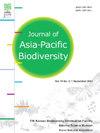Foraging behavior and pollination efficiency of generalist floral visitors of Leucas aspera (Willd.) link (Lamiaceae)
IF 0.6
Q4 BIODIVERSITY CONSERVATION
引用次数: 0
Abstract
Pollination services from insects are important for the reproductive success of flowering plants. Measuring the effectiveness of floral visitors provide relative contributions of different insect taxa to pollination services. Here, we tested the efficiency of pollinators visiting flowers of Leucas aspera based on single-visit pollen deposition and visitation frequency. We monitored the visitation behaviors of different insects during the peak flowering seasons. We observed a total of 23 insect taxa representing three orders and eight families, among them 18 floral visitors deposited a significant proportion of pollen grains on the stigma. The flower handling time was significantly higher for most butterfly species relative to bees and flies. The number of flowers and inflorescences visited during each foraging bout varied significantly among pollinators. The proportion of conspecific and heterospecific pollen deposited on the stigma varied significantly among floral visitors. L. aspera was not pollen-limited, and the presence of fruit and seed sets in the pollinator exclusion treatments indicated a self-compatible breeding system. Overall, the findings suggested that the different flower visitors of L. aspera provide complementary pollination services and highlight the importance of having diverse communities of pollinators to ensure successful pollination and reproductive success.
Leucas aspera(Willd.
昆虫的授粉服务对开花植物的繁殖成功非常重要。测量访花昆虫的效率可提供不同昆虫类群对授粉服务的相对贡献。在此,我们根据单次访花的花粉沉积量和访花频率,测试了传粉昆虫的访花效率。我们在开花旺季监测了不同昆虫的访花行为。我们共观察到 3 目 8 科 23 种昆虫类群,其中 18 种访花者在柱头上沉积了相当大比例的花粉粒。与蜜蜂和苍蝇相比,大多数蝴蝶种类的花处理时间明显较长。不同传粉媒介在每次觅食过程中访问的花朵和花序数量差异很大。同种和异种花粉沉积在柱头上的比例在访花者之间有显著差异。阿斯佩拉花不受花粉限制,在排除传粉昆虫的处理中结出的果实和种子表明这是一种自交繁殖系统。总之,研究结果表明,L. aspera 的不同访花者提供了互补的授粉服务,并强调了拥有不同授粉者群落对确保成功授粉和繁殖成功的重要性。
本文章由计算机程序翻译,如有差异,请以英文原文为准。
求助全文
约1分钟内获得全文
求助全文
来源期刊

Journal of Asia-Pacific Biodiversity
Agricultural and Biological Sciences-Insect Science
CiteScore
1.70
自引率
12.50%
发文量
94
审稿时长
27 days
期刊介绍:
The Journal of Asia-Pacific Biodiversity (previous title was Journal of Korean Nature) is an official journal of National Science Museum of Korea (NSMK) and Korea National Arboretum (KNA). The scope of journal is wide and multidisciplinary that publishes original research papers, review articles, as well as conceptual, technical and methodological papers on all aspects of biological diversity-its description, analysis and conservation, and its application by humankind. This wide and multidisciplinary journal aims to provide both scientists and practitioners in conservation theory, policy and management with comprehensive and applicable information. However, papers should not be submitted that deal with microorganisms, except in invited paper. Articles that are focused on the social and economical aspects of biodiversity will be normally not accepted.
 求助内容:
求助内容: 应助结果提醒方式:
应助结果提醒方式:


